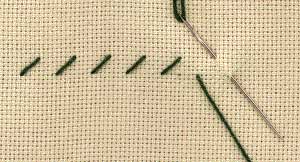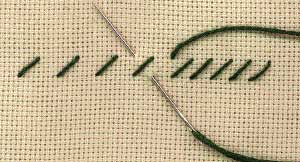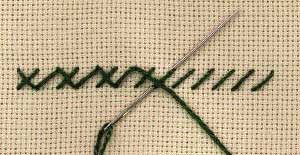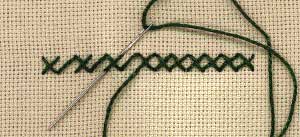Alternating Cross Stitch
Part of the Cross stitch family

![]()
Alternating Cross stitch is only suitable for even weave fabrics. The advantage to working cross stitch in this manner is that the stitches on the reverse of the fabric form also a cross stitch.
Since cross stitch is one of the oldest stitches in the world many variations are practiced. Cross stitch is used mainly on even-weave fabrics, where the threads can be counted. Although the actual construction of cross stitch remains the same, there are different methods of working.
If working cross stitch in a traditional manner one rule applies to all methods. The top diagonal stitches must always fall in the same direction. I should point out however, that in contemporary embroidery this rule is sometimes broken.
To work cross stitch using this method, first work every second diagonal stitch of the bottom row.
On the return journey work the missing diagonal stitches.

On the third journey work every second top diagonal stitch then return working the final top diagonals.

Cross Stitch Family.
Cross stitch is based on the simple action of crossing one thread against the other. This action in stitching has been used around the globe since the beginning of textile history. For this reason, there are many variations to Cross stitch and some listed here. They are Alternating cross stitch, Rice stitch, Double cross stitch, Long arm cross stitch and Montenegrin. There are many more.
